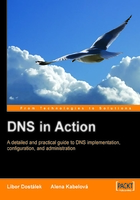
Conventions
In this book, you will find a number of styles of text that distinguish between different kinds of information. Here are some examples of these styles, and an explanation of their meaning.
There are three styles for code. Code words in text are shown as follows: "We can include other contexts through the use of the include directive."
A block of code will be set as follows:
[statistics-file path_name] [zone-statistics yes_or_no] [auth-nxdomain yes_or_no] *[deallocate-on-exit yes_or_no] [dialup dialup_option]
When we wish to draw your attention to a particular part of a code block, the relevant lines or items will be made bold:
[statistics-file path_name]
[zone-statistics yes_or_no]
[auth-nxdomain yes_or_no]
*[deallocate-on-exit yes_or_no]
[dialup dialup_option]
Any command-line input and output is written as follows:
$ORIGIN default_domain
New terms and important words are introduced in a bold-type font. Words that you see on the screen, in menus or dialog boxes for example, appear in our text like this: "clicking the Next button moves you to the next screen".
Note
Warnings or important notes appear in a box like this.